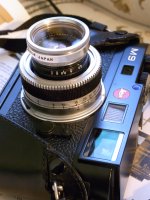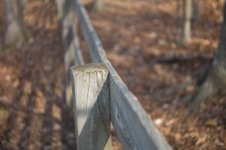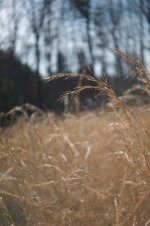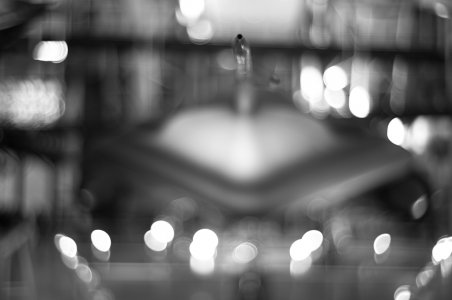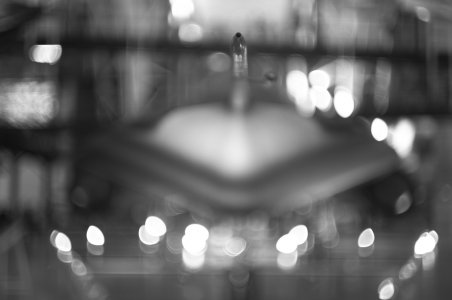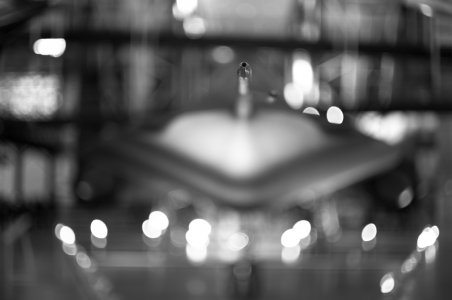wjlapier
Well-known
Ambro51
Collector/Photographer
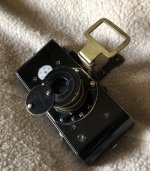 The UR Leica was replicated in small numbers during the ‘70s. Built strictly for display, little inside, or optically, was designed “to work”. About a half dozen have been modified to Work....to take pictures how Barnack did around the WW1 era. I’m lucky to have two working URs, one, #9, I modified myself, this one, #80, was rebuilt by Mr Kim in Seoul and used the same Leitz 42mm Summar That Barnack used. .....questions often arise from the large finder, seen on the original UR (and which I copied). The true story is that the original UR did not come down from 1913 wearing the finder we see in pictures. It was instead built Later, using drawings and sketches Barnack made. •••. All in all, a Very Sweet little Camera!
The UR Leica was replicated in small numbers during the ‘70s. Built strictly for display, little inside, or optically, was designed “to work”. About a half dozen have been modified to Work....to take pictures how Barnack did around the WW1 era. I’m lucky to have two working URs, one, #9, I modified myself, this one, #80, was rebuilt by Mr Kim in Seoul and used the same Leitz 42mm Summar That Barnack used. .....questions often arise from the large finder, seen on the original UR (and which I copied). The true story is that the original UR did not come down from 1913 wearing the finder we see in pictures. It was instead built Later, using drawings and sketches Barnack made. •••. All in all, a Very Sweet little Camera!Ambro51
Collector/Photographer
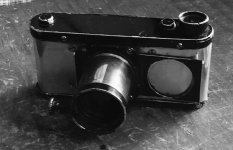 Oscar Barnacks very first still camera to use 35mm film, the “Mikro cinema apparatus”, or as we know it, the Exposure Tester Camera, was built in 1912 to determine the correct development of films used the his all metal Kino Camera. •••. The camera used the same Zeiss Kino Tessar f 3.5 5cm and takes 1” round images. It mounts vertically, and the slide with the hole is flicked upwards to make the Exposure. Leitz still has the original, check Mike Eckman’s site for a review of this camera, known as M875 from its museum acsention number.
Oscar Barnacks very first still camera to use 35mm film, the “Mikro cinema apparatus”, or as we know it, the Exposure Tester Camera, was built in 1912 to determine the correct development of films used the his all metal Kino Camera. •••. The camera used the same Zeiss Kino Tessar f 3.5 5cm and takes 1” round images. It mounts vertically, and the slide with the hole is flicked upwards to make the Exposure. Leitz still has the original, check Mike Eckman’s site for a review of this camera, known as M875 from its museum acsention number.TenEleven
Well-known
Maybe not as shockingly rare as some other things shown here, but still very interesting. The "legendary" Half-Sonnar. The Tokyo Kogaku Topcor 50/1.5, second version. The front group is a typical Sonnar, the rear group is that of a double Gauss. It is worth to point out that the curvatures of the lens are in the same direction compared to the cemented doublet of a f/2 Sonnar, but are of a much stronger value. And of course in typical double Gauss style the Topcor has a rear convex lens, which is of a surprising size and goes almost all the way to the RF cam.

Four way comparison. These lenses are from various makers so curvatures shouldn't be taken as matter-of-fact. We're talking archetypes here.
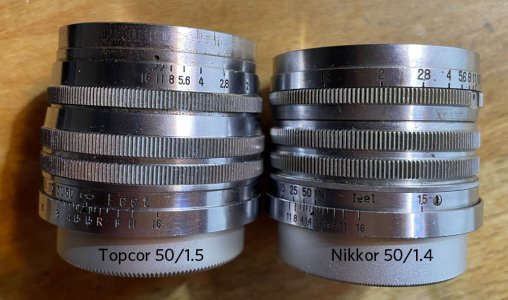
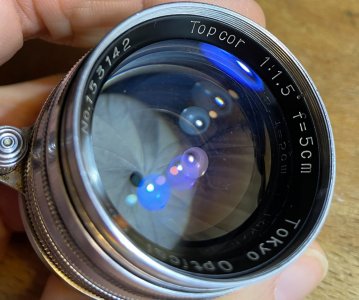
You can see that the lens is quite a bit stout compared to most double Gauss types, at the same time being a bit longer than say the Nikkor 50/1.4 LTM.
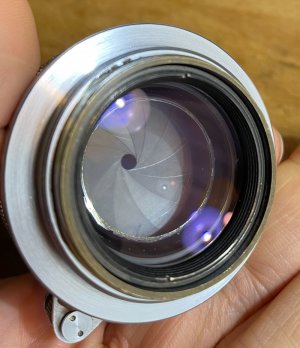
This is speculation on my part, but it seems possible that the aperture value of f/1.5 might not have been due to the lens "Sonnar-ness" but Tokyo Kogaku simply hitting the boundaries of what could be done with the throat-size of the Leica Thread Mount. Native Sonnar lenses, by comparison, have a much smaller rear diameter and face less issues in this area, hence a lot of the early super-speeds (Zunow 1.1, Fuji 1.2) being Sonnar types.
The rendering is quite detailed sharp in the center from wide open. There is considerable (spherical aberration?) glow at the wider apertures. It might be also due to my copy not being the best. It covers a larger area than with a typical Sonnar design, but the contrast and therefore impact of the flare itself is lower. Imaging contrast is also on the low side and coma is well controlled. Stopping down improves peripheral resolution quickly but does little for the center resolution or contrast which stay flat. There is no distortion that I can see, the very slight pincushion distortion common with early 50/1.5 Sonnars is absent.
The defocus has sharp outlining in highlights, atypical, but not unheard of for Sonnar designs (Russian and war-time Sonnars sometimes have it as they try to further correct for Spherical aberration) with the highlight shape becoming cats-eye like akin to typical double Gauss lenses approaching the corners. The focus fall-off is a strange hybrid of Sonnar and Gauss. Gone are the Sonnar typical "melting" backgrounds - background elements retain their shape and texture, however the focus fall-off is Sonnar like and very gradual with no clear delineation of the focal plane.
I would be interested to know if @Sonnar Brian (or anyone else) has experiences with it.
My copy is not the prettiest with quite a bit of scratches on the front, otherwise clean optically after I took it apart and reset the aperture. It has been well used, this I was happy to pay quite a bit less than the usual asking price which would have been over budget for me.

Four way comparison. These lenses are from various makers so curvatures shouldn't be taken as matter-of-fact. We're talking archetypes here.


You can see that the lens is quite a bit stout compared to most double Gauss types, at the same time being a bit longer than say the Nikkor 50/1.4 LTM.

This is speculation on my part, but it seems possible that the aperture value of f/1.5 might not have been due to the lens "Sonnar-ness" but Tokyo Kogaku simply hitting the boundaries of what could be done with the throat-size of the Leica Thread Mount. Native Sonnar lenses, by comparison, have a much smaller rear diameter and face less issues in this area, hence a lot of the early super-speeds (Zunow 1.1, Fuji 1.2) being Sonnar types.
The rendering is quite detailed sharp in the center from wide open. There is considerable (spherical aberration?) glow at the wider apertures. It might be also due to my copy not being the best. It covers a larger area than with a typical Sonnar design, but the contrast and therefore impact of the flare itself is lower. Imaging contrast is also on the low side and coma is well controlled. Stopping down improves peripheral resolution quickly but does little for the center resolution or contrast which stay flat. There is no distortion that I can see, the very slight pincushion distortion common with early 50/1.5 Sonnars is absent.
The defocus has sharp outlining in highlights, atypical, but not unheard of for Sonnar designs (Russian and war-time Sonnars sometimes have it as they try to further correct for Spherical aberration) with the highlight shape becoming cats-eye like akin to typical double Gauss lenses approaching the corners. The focus fall-off is a strange hybrid of Sonnar and Gauss. Gone are the Sonnar typical "melting" backgrounds - background elements retain their shape and texture, however the focus fall-off is Sonnar like and very gradual with no clear delineation of the focal plane.
I would be interested to know if @Sonnar Brian (or anyone else) has experiences with it.
My copy is not the prettiest with quite a bit of scratches on the front, otherwise clean optically after I took it apart and reset the aperture. It has been well used, this I was happy to pay quite a bit less than the usual asking price which would have been over budget for me.
Last edited:
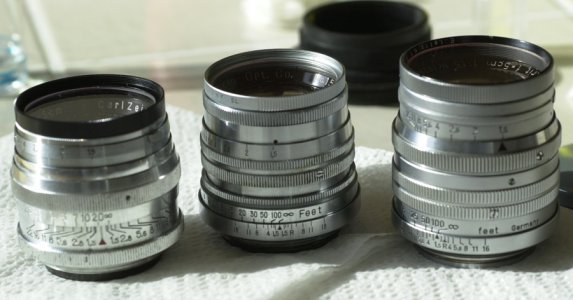
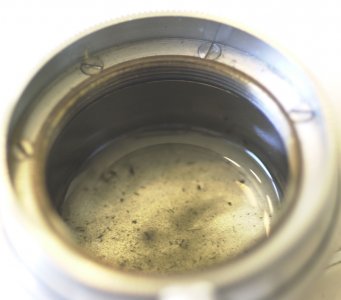
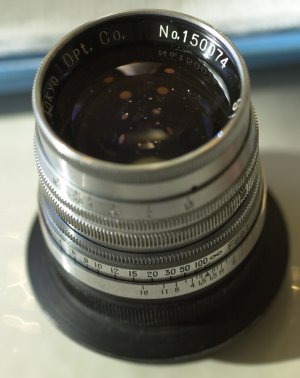
The optical block diagram looks the same as my Simlar 5cm F1.5, the 74th made. Mine stops down to F16 and uses 39mm filters. There is an earlier version- probably ~60 made that stops down to F12.5, and follows the older Leica F-Stop series. Internally, mine is scribed "10" and my speculation is this is the 10th made with F16. The optical block diagram is the same as the later Canon 85/1.5, a 1-3-2-1 7-element in 3-group. I believe it is a double-Gauss where the front doublet has been split into 3 elements of lesser power. The front and rear sections of the lens are image forming optics, as they are in the Sonnar and other double-Gauss lenses. The ratio of the focal length of each section is not as high as that of the Sonnar.
Mine was inoperative when received. 4 days of soaking in solvent to get the old lubricants out. The glass is perfect. The machining of the lens- I had to put the 6 main screws into the same holes they came out of, they were not interchangeable. The lens came with a 4-digit Leotax D-IV, also very uncommon. The camera- sent it to Youxin for new curtains and a rebuild.
Last edited:
TenEleven
Well-known
Very instructive reply, thank you.First Shot is with the Simlar 5cm F1.5,
View attachment 4816127
Second shot with the Leica Xenon 5cm F1.5, wide-open.
View attachment 4816128
One thing I notice is that the Simlar lens retains more of the central quadratic shapes geometry than the Xenon/Summitar.
This is most apparent on the top of the object where it is differentiated more clearly from the background.
And yeah I also considered it being a Gauss type with the elements split up, however if the total power of the front group was lower (aka as in a normal Gauss type) wouldn't the lens as a whole not need to be longer? My understanding is, that the Sonnar type designs achieve their stoutness by having a very high powered and long focal length front group which is then "reduced down" by the rear triplet/doublet.
I've noted that on Sonnar formula lenses that the rear section has a focal length of "about" the same as the complete lens. The front section is much longer focal length. The Simlar- took mine apart many years ago, did not take relative measurements. The rendering is very similar to the older Xenon, which splits the rear element into two of lower strength. I've read that the Simlar was computed in 1937.
Alberti
Well-known
Brian, thanks, but … “
I would love to see this with a Summitar 1.5 too.
… I still can’t figure out what this is that is depicted, even though the Canon image shows more natural (but then I have that), what this space object is. (Guess from memory - it is the pointer of a jet fighter; saw a post some 8-10 years ago with such a pointer) . Simlar is a most ‘mystery making’ lens. The uncommon bokeh shape might be due to that of course.Gone are the Sonnar typical "melting" backgrounds - background elements retain their shape and texture
I would love to see this with a Summitar 1.5 too.
Last edited:
I'll look for Summarit shots-Brian, thanks, but … “
… I still can’t figure out what this is that is depicted, even though the Canon image shows more natural (but then I have that), what this space object is. (Guess from memory - it is the pointer of a jet fighter; saw a post some 8-10 years ago with such a pointer) . Simlar is a most ‘mystery making’ lens. The uncommon bokeh shape might be due to that of course.
I would love to see this with a Summitar 1.5 too.
This is the SR-71 "Blackbird", the Mach3 aircraft designed by Kelly Johnson.
dexdog
Mentor
Pitot tube on the nose?
Must be- not a gun! I remember reading about this plane as a Kid, when it was the YF-12.
dexdog
Mentor
Guns don't work on an SR-71, because the plane at really high altitude is faster than the bullet. Let that sink in...
boojum
Mentor
That and it was not meant to do anything but snoop. Weight reduction was a big priority, and lots of Russian titanium went into them, unbeknown to the Russians, of course. Just a great piece of engineering, so great it is still in use, for weather. Yeah, right. LOL And beautiful to look at.
Yokosuka_Mike
Abstract Clarity
IIRC: SR-71 pilots wear astronaut wings on their uniform.
When I was on the USS Beaufort (ATS-2), we salvaged a crashed SR-71 off the coast of the Philippines. A small team of Navy Seals was was deployed with us in case any bad guys tried anything. It was an interesting job.
You can read about it here Luzon Crash
All the best,
Mike
When I was on the USS Beaufort (ATS-2), we salvaged a crashed SR-71 off the coast of the Philippines. A small team of Navy Seals was was deployed with us in case any bad guys tried anything. It was an interesting job.
You can read about it here Luzon Crash
All the best,
Mike
dexdog
Mentor
I
There were several X-15 pilots that earned their astronaut wings in that craft, the first "re-usable spaceship". Astronaut wings require exceeding an altitude of 50 miles. The X-15 could do that. The SR-71 hit 85,000feet, about 1/3rd of that required.IIRC: SR-71 pilots wear astronaut wings on their uniform.
Mike
JeffS7444
Well-known
Top: Early type Zenit-122 with cyrillic lettering, small shutter speed dial, "CC" markings on self timer button, paint-filled markings, and film reminder slot on bottom right. "Made in USSR".
Bottom: Common late-model Zenit-122K as sold by Lomography. Markings are thermal transfers (protective film is my own addition). "Made in Russia". Besides the change to Pentax K mount, and omitted PC flash synch terminal, the newer camera weighs less due to increased use of plastics, has brighter viewfinder and brighter LED meter lights.
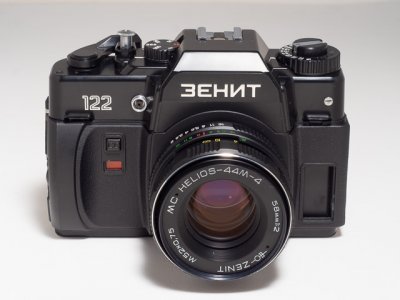
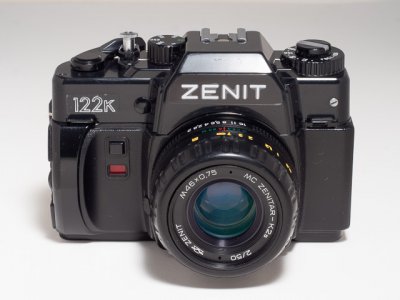
Bottom: Common late-model Zenit-122K as sold by Lomography. Markings are thermal transfers (protective film is my own addition). "Made in Russia". Besides the change to Pentax K mount, and omitted PC flash synch terminal, the newer camera weighs less due to increased use of plastics, has brighter viewfinder and brighter LED meter lights.


Share:
-
This site uses cookies to help personalise content, tailor your experience and to keep you logged in if you register.
By continuing to use this site, you are consenting to our use of cookies.



